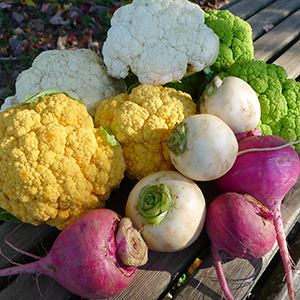
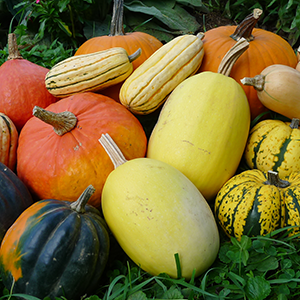
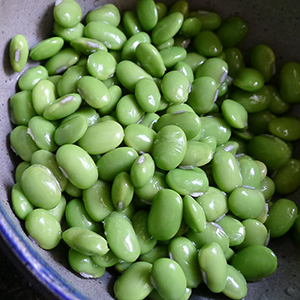

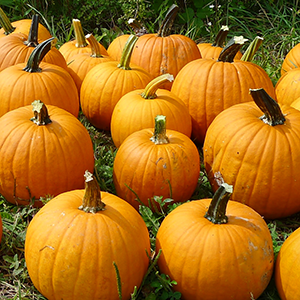
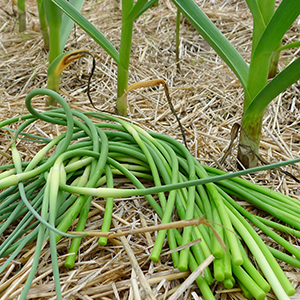
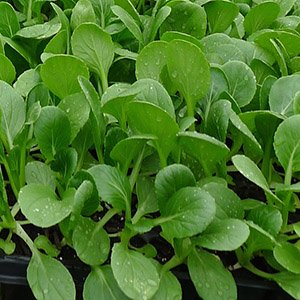



News and Notes | The Anchor Run Blog
Posts Filtered by Month - September 2017 |
Show Recent Posts
September 24, 2017
Final Potluck of the 2017 Season (Band Included)!
by Dana Hunting
Final Potluck of the 2017 Season (Band Included)!
by Dana Hunting
Come see these talented musicians at the farm Saturday October 7th from 4 pm 'til dark for our season's end celebration potluck! Bring a dish to share that is large enough to feed 4-6 adults, your own place settings, beverages of your choice, as well as lawn chair or blanket. Local bluegrass/folk band Goose Creek Pioneers will serenade us during the evening and there will be a campfire to warm your bones by. Bring your s'more material and tools of the roasting trade, hope to see you there!


September 24, 2017
Workshifts Scheduled for Week of 9/24/17
By Derek McGeehan
Workshifts Scheduled for Week of 9/24/17
By Derek McGeehan
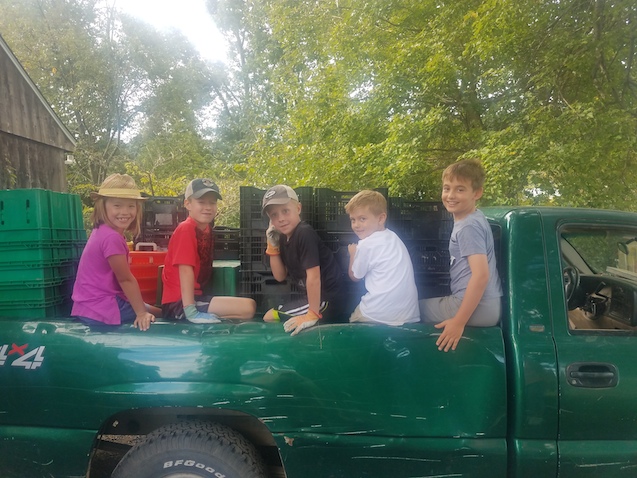
Prepared to help harvest sweet potatoes! (photo courtesy of Alescia Dingle)
If you still need to work your pledged hours please consider signing up for a workshift soon! In other words, when you joined the CSA you purchased a share "with work discount" instead of a share "without working". If you'd rather contribute financially to cover the work hour cost of your share please do so soon so that we can plan accordingly. And please don't feel guilty about it! The buyout option makes it fair for all members.
$60 covers the 4 hours for a Half Share; $90 covers the 6 hours for a Medium Share; and $120 covers the 8 hours for a Full Share. E-mail us at anchorruncsa@gmail.com if you have any questions.
Workshifts this week:
- Tuesday 9/26 10am-12noon
- Wednesday 9/27 10am-12noon
- Sunday 10/1 8-10am (in High Tunnel so rain or shine)
- Wednesday 9/27 10am-12noon
- Sunday 10/1 8-10am (in High Tunnel so rain or shine)
Workshift sign-up instructions may be found here.
Thank you!

September 24, 2017
Green is Now the Color of Fall
By Derek McGeehan
Green is Now the Color of Fall
By Derek McGeehan
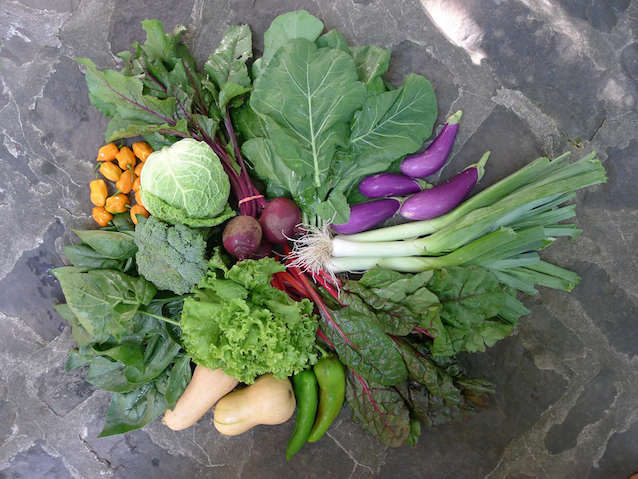
Harvest #20 (Week B) should include butternut winter squash, leeks, kale, collards, spinach, Swiss chard, lettuce, savoy cabbage, beets with greens, broccoli, dill, cilantro, parsley, hot peppers, sweet peppers, eggplant, and tomatoes. Some items will be a choice. U-pick should include herbs.

September 24, 2017
Summer in Fall
By Derek McGeehan
Summer in Fall
By Derek McGeehan
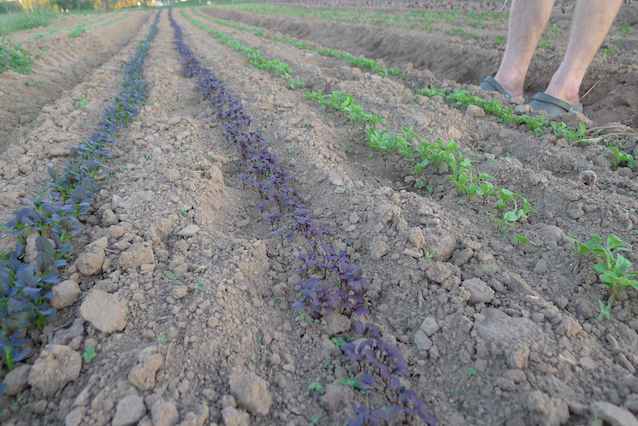
Two new beautiful varieties of mizuna/mild mustard greens in shades of red do look a bit thirsty.
This is the driest our soil has been all season long. We received just over an inch of rain almost 3 weeks ago and since then we've received .15 inches (which was almost 2 weeks ago). We added drip irrigation to the more sensitive water demanding crops of broccoli, cauliflower, and cabbage, mostly because they're all beginning to head up and reach maturity. Years ago I remember reading that the brassica family is less able to scavenge for moisture than, say, the lettuce family. Daily I think about adding water to all of the other crops but with this heat I'm a little worried that if I add water these late fall crops will grow too fast and reach maturity too soon. But, given the high temperatures and low humidity plus wind, crops and soil are drying out faster. For now, we wait and hope for some rainfall to take away this difficult decision.
Even though it is very dry, the sun is lower in the sky and is out for much less time than it would be in July. We also benefit from fields that face north, have high organic matter, and have good soil structure, properties that conserve moisture in the soil. As you can tell below, even after a hot and dry day the mature greens still look healthy and happy. That's a big field to have to irrigate!
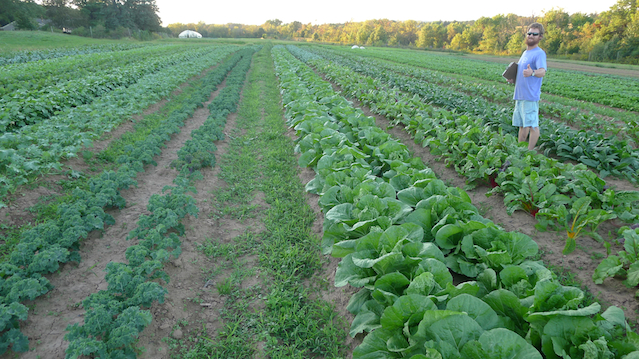

September 24, 2017
Late Fall CSA and Winter CSA Memberships Available
By Derek McGeehan
Late Fall CSA and Winter CSA Memberships Available
By Derek McGeehan
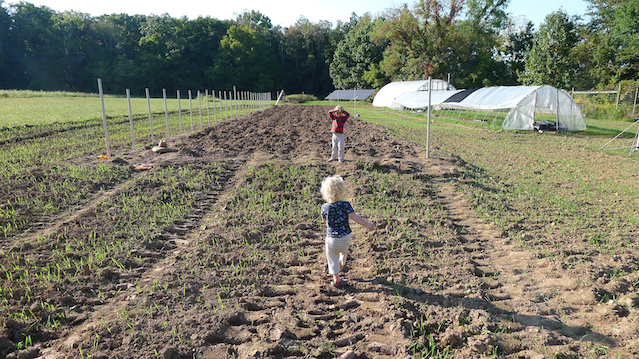
Membership is now available for the 2017 6-week Late Fall CSA (mid-Nov through mid-Dec) as well as the 2017-2018 10-week Winter CSA (end-Dec through end-Feb). Click here for more information and to sign up!

September 24, 2017
A Very Large Variety
By Linda Dansbury
A Very Large Variety
By Linda Dansbury
The fall provides us with a large variety of veggies that combine well with greens - find a couple recipes that are your favorites and then vary the ingredients based on what you have on hand. It is fun to experiment and find new flavor combinations.
This week I did quite a bit of cooking. I love hanging out in the kitchen and do so when the opportunity presents itself. Here are a few of the things I prepared:
Swiss chard, onion, garlic - this might be my new "go to" method for cooking greens. Heat olive oil/butter combo in a large saute pan. Add thinly sliced onion, cover and saute over low until tender. Add finely chopped garlic - a good amount - and continue sauteing until tender - add a little salt and pepper. Meanwhile, remove stems from chard leaves and chop - add them to the onion/garlic mix and cook until tender. Chop chard leaves and add to the pan and keep moving them around until wilted and tender. Add salt and pepper to taste and a squeeze of lemon if desired.
Eggplant, rosemary - I cut the eggplants in half longway and sliced through the flesh to make a cross hatch pattern. Brushed with olive oil, a little salt and pepper and a sprig of rosemary on each half. Then roasted in a 450 degree oven until the flesh was nicely charred and very soft under the char. Drizzled with some tahini that I had: crushed a little garlic into lemon juice, added to tahini and then added water until it was thin enough to pour. Yum!
Onion, hot pepper, tomatillo sauce from freezer, cilantro - made the Chicken Stew with Tomatillo Sauce from a batch in the freezer. I made mine in the pressure cooker and served rolled up in corn tortillas, with the sauce poured over and a crumble of local feta cheese and chopped cilantro.
Kale, garlic, cilantro - made the Kale Rice Bowl (a newly added recipe) that is one of our "go to" weeknight dishes. I discovered it a couple of years ago when we had a lot of baby kale during the late fall share and we have been eating it ever since.
Share with me how you enjoy your harvest by emailing me at lindadansbury@comcast.net.

September 24, 2017
New Green - Collards
By Linda Dansbury
New Green - Collards
By Linda Dansbury
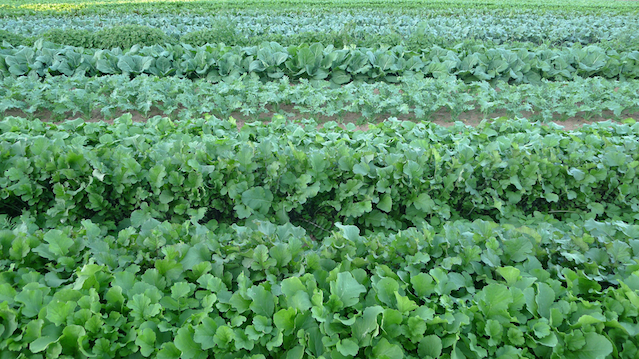
Can you find the collards in the sea of green (hint: about 25% of the way down from the top)?
Collards seem to be one of those greens that people either love or hate. Honestly, it hasn't been one of my favorites but when done right, the bitterness is lessened and they are almost creamy in texture - most people are aware of the Southern method of cooking them for hours with a ham hock or other smoked meat. But how do you do them so you don't have them going all day?
You can remove the stems, roll up the leaves and cut into a chiffonade - the way you would when making cabbage. By making the leaves small, they will cook faster - add them into greens recipes with other greens. We also have a few nice recipes on this site including Skillet Squash with Collards and Barley, Collard Greens with Lima Beans and Smoked Turkey and even Collard Pesto. Try them, they are too healthy to not eat them!
Collards store pretty well, keeping longer in the fridge than most other greens.

September 24, 2017
How to enjoy all of these greens?
By Linda Dansbury
How to enjoy all of these greens?
By Linda Dansbury
Fellow member Carolyn Diana sent me the following email. I love how this recipe sounds and I even purchased the coconut milk to make it, but haven't tried it yet. I hope to this coming week. Thank you Carolyn - it sounds delicious!
I wanted to share what I do when we get an enormous load of greens at the farm (my favorite type of pick up!! ;D)
Coconut Honey-Miso Greens
I first saute an onion with some garlic, salt, and pepper in coconut oil. Once the onion is tender, mix in about 3 tablespoons of a high quality yellow miso paste (I get ours from a local co-op, and the quality really does make a difference) and about half a tablespoon of raw honey. Mix thoroughly. Then add in whatever mess of greens you have available: kale, swiss chard, beet or dandelion greens, etc. Mix with a little tamari or soy sauce, and enough coconut milk to achieve the consistency you'd like. I add enough coconut milk to make it quite saucy and then serve over rice.
I first saute an onion with some garlic, salt, and pepper in coconut oil. Once the onion is tender, mix in about 3 tablespoons of a high quality yellow miso paste (I get ours from a local co-op, and the quality really does make a difference) and about half a tablespoon of raw honey. Mix thoroughly. Then add in whatever mess of greens you have available: kale, swiss chard, beet or dandelion greens, etc. Mix with a little tamari or soy sauce, and enough coconut milk to achieve the consistency you'd like. I add enough coconut milk to make it quite saucy and then serve over rice.

September 17, 2017
Autumnal Delights
By Derek McGeehan
Autumnal Delights
By Derek McGeehan
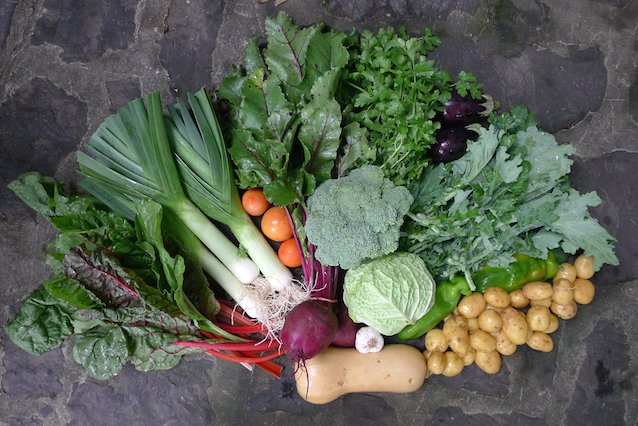
Harvest #19 (Week A) should include winter squash (spaghetti, dumpling, butternut), leeks, onions, potatoes, Swiss chard, kale, sweet peppers, eggplant, tomatoes, savoy cabbage, beets with greens, scallions, garlic, parsley, dill, cilantro, Italian dandelion, and hot peppers. Some items will be a choice and may not be available during all pick up times. U-pick in the main field is over so that we can sow cover crops but perennial and annual herbs from the herb garden are available.

September 17, 2017
Workshifts Scheduled for Week of 9/17/17
By Derek McGeehan
Workshifts Scheduled for Week of 9/17/17
By Derek McGeehan
If you still need to work your pledged hours please consider signing up for a workshift soon! In other words, when you joined the CSA you purchased a share "with work discount" instead of a share "without working". If you'd rather contribute financially to cover the work hour cost of your share please do so soon so that we can plan accordingly. And please don't feel guilty about it! The buyout option makes it fair for all members.
$60 covers the 4 hours for a Half Share; $90 covers the 6 hours for a Medium Share; and $120 covers the 8 hours for a Full Share. E-mail us at anchorruncsa@gmail.com if you have any questions.
Workshifts this week:
- Wednesday 9/20 5-7pm
- Friday 9/22 10am-12noon
- Sunday 9/24 8-10am
- Friday 9/22 10am-12noon
- Sunday 9/24 8-10am
Workshift sign-up instructions may be found here.
Thank you!

September 17, 2017
Late Fall CSA and Winter CSA Membership Now Available
By Derek McGeehan
Late Fall CSA and Winter CSA Membership Now Available
By Derek McGeehan
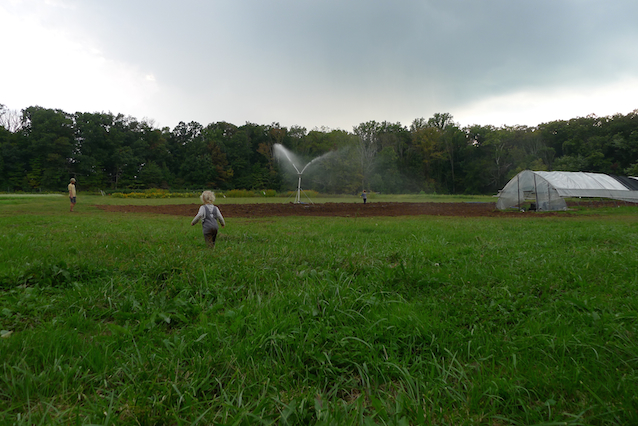
Watering in grass and clover seed sown in the subtle swales that were created for water management around our replacement movable 'hoop tunnel'. The original structure collapsed under snow load way back during the winter of 2010-2011. This simple structure of metal pipes covered in plastic provides enough protection to allow cold-hardy plants to thrive during the winter months. Think spinach, lettuce mix, baby Swiss chard, claytonia, and bok choy.
2017 Late Fall CSA
- Full, Medium, and Half Shares are available for the 6th annual 6-week season.
- Prices remain the same as last season: $180 for Full; $130 for Medium; $100 for Half.
- A deposit of $50 or full payment secures your share; full payment is due by November 1st; if you join after November 1st full payment is due to finalize registration.
- Pick up days are: Wednesday 1-8pm or Saturday 11am-12noon (you choose a day but you can switch temporarily by notifying us in advance).
- Begins immediately following conclusion of Main Season CSA Harvest Week #26 (Week B, week of November 5th).
- Late Fall Harvest #1 (Week A) is scheduled for week of November 12th.
- Concludes week of December 17th.
- No workshift discount/commitment.
- A cold hardy fall themed continuation of the Main Season share with tasty staples like chard, spinach, lettuce, radicchio, arugula, mizuna, tatsoi, bok choy, kale, collards, cabbage, Napa cabbage, cilantro, dill, parsley, leeks, garlic, scallions, onions, beets, radishes, turnips, carrots, celeriac, kohlrabi, potatoes, and sweet potatoes.
- Each cold season we make improvements to ensure a steady supply of fresh crops, not just storage ones. We now use 4 growing structures to extend the growing season; during our first Late Fall CSA back in 2012 we only had the high tunnel. So, our footprint has effectively tripled (each structure differs somewhat in size) and we now also add heat to the greenhouse for insurance/assurance.
- A Full Share receives approximately 8-12 pounds of produce weekly, a Half Share every other week, and a Medium Share receives 2/3 of a Full Share weekly.
- **During the week of Thanksgiving, Late Fall Harvest Week #2, Wednesday's pick up is on Tuesday, November 21st to accommodate travelers and holiday schedules (we'll accommodate your schedule, too)**. This is the only pick up anomaly.
- To join, log in to the website here; the 'join' button will be on the left hand side of your members page.
- Membership is limited and is at capacity at around 50% of the Main Season number so don't delay!
- Worried about farm accessibility this time of year? Don't worry! Our goal is to keep the driveway clean and tidy with stone applications as needed (i.e. fill in the potholes). Last winter our tractor was at the shop for months so we were less able to maintain the driveway - sorry for that!
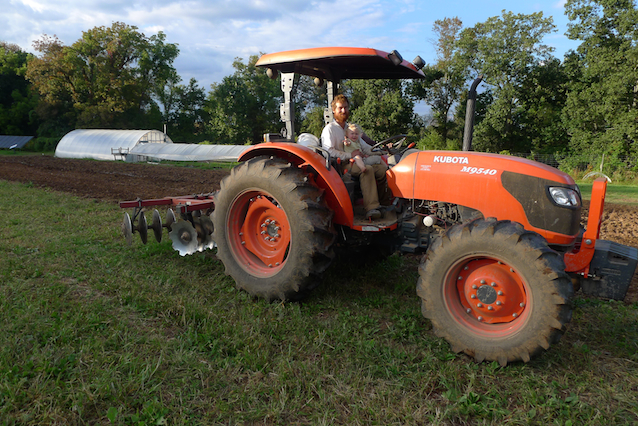
Abigail is learning how to drive the 95-hp tractor...
2017-2018 Winter CSA
- Full, Medium, and Half Shares are available for the 2nd annual 10-week season (2 more weeks than last year).
- Prices remain the same as last season: $300 for Full; $220 for Medium; $165 for Half.
- A deposit of $75 or full payment secures your share; full payment is due by December 15th.
- Pick up days are: Wednesday 1-8pm or Saturday 11am-12noon (you choose a day but you can switch temporarily by notifying us in advance).
- Begins immediately following conclusion of Late Fall CSA Harvest Week #6 (Week B, week of December 17th).
- Winter Harvest #1 (Week A) is scheduled for week of December 24th - **This week only, Wednesday's pick up is moved to Thursday, December 28th, to accommodate travelers and holiday schedules (we'll accommodate your schedule, too)**. This is the only pick up anomaly.
- Concludes week of February 25th.
- No workshift discount/commitment.
- A cold hardy winter themed continuation of the Late Fall share with tasty staples like chard, spinach, lettuce, arugula, mizuna, tatsoi, bok choy, kale, collards, cabbage, Napa cabbage, herbs, leeks, garlic, scallions, onions, beets, radishes, turnips, carrots, celeriac, kohlrabi, and potatoes.
- Each cold season we make improvements to ensure a steady supply of fresh crops, not just storage ones. We now use 4 growing structures to extend the growing season; during our first Late Fall CSA back in 2012 we only had the high tunnel. So, our footprint has effectively tripled (each structure differs somewhat in size) and we now also add heat to the greenhouse for insurance/assurance.
- A Full Share receives approximately 8-12 pounds of produce weekly, a Half Share every other week, and a Medium Share receives 2/3 of a Full Share weekly.
- To join, log in to the website here; the 'join' button will be on the left hand side of your members page.
- Membership is limited and is at capacity at around 30% of the Main Season number so don't delay!
- Worried about farm accessibility this time of year? Don't worry! Our goal is to keep the driveway clean and tidy with stone applications as needed (i.e. fill in the potholes). Last winter our tractor was at the shop for months so we were less able to maintain the driveway - sorry for that!

September 17, 2017
Covering the Equinox
By Derek McGeehan
Covering the Equinox
By Derek McGeehan
By this time of year a significant portion of the fields that grow our produce is already growing another type of crop that is fundamental to the health of our soil: a cover crop. It's a fairly generic term but is so important and vital to continued soil health and improvement that it warrants continual conversation, experimentation, and observation (and photos). We consider cover crops to be 'green manure' because they're a good substitute for traditional manure thanks to their ability to photosynthesize the sun's light energy and they're returned to the soil unharvested.
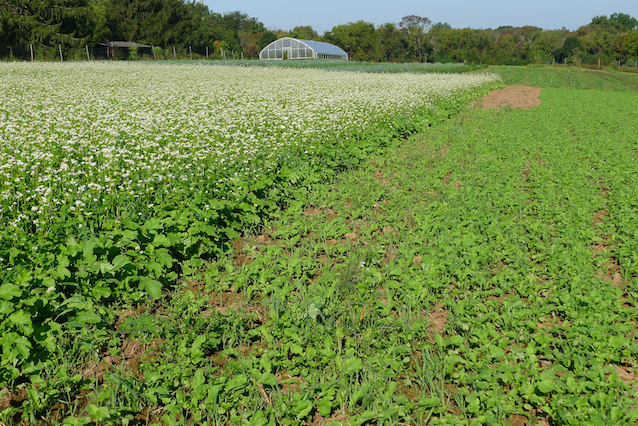
Above, a cover crop mixture of buckwheat, daikon radish, oats, and crimson clover was sown on August 11th and is next to the same mixture sown a few weeks later on August 29th. The older mix was sown after onions and the 3rd succession of summer squash and cucumbers. The younger mix was sown after the 1st planting of watermelon and the 2nd succession of summer squash and cucumbers. Because we use a tractor mounted spin spreader to sow the covers we wait until a minimum of 6 contiguous beds are empty of their cash crops.
The benefits of cover cropping were lodged into our brains a decade ago when we were aspiring new/young farmers. Over that succeeding decade we've developed and adapted a cover cropping scheme that works really well for us here, both in terms of our farming schedule and crop plan and probably most importantly in soil health and improvement. Along the way there was much trial by error and certain species were removed from out list of options. We still make some mistakes and learn, such as by allowing last year's buckwheat to go to seed and then dealing with the subsequent weed pressure of those volunteers this year.
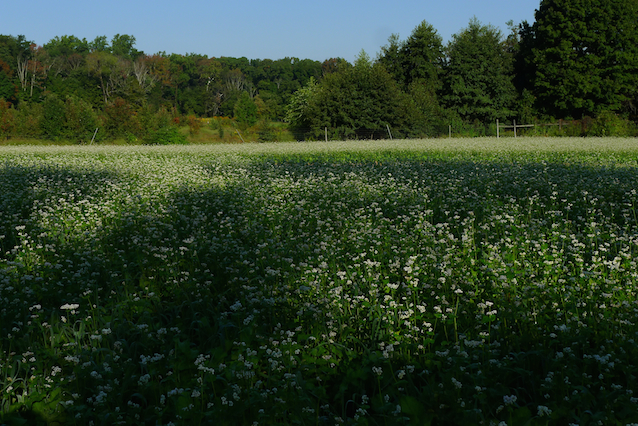
Above, this is an early morning scene of our favorite mix of buckwheat, daikon radish, oats, and crimson clover also sown on August 11th.
Sometimes it helps to work backwards when deciding on the species to sow. Ask: What are we planning to use this ground for later this season, next season, and does it need a long-term fallow rest? Later intentions help determine what to sow now. We've refined what we grow to a half dozen species: grasses/grains like oats, buckwheat, winter rye; legumes to fix nitrogen like peas and crimson clover; and a lone brassica, the mighty daikon radish. Our predominant fall/winter mix is buckwheat, oats, daikon, and crimson clover, mostly because everything but the clover dies off over the winter leaving the ground very usable in the spring. Depending on when we sow the clover it also dies in the winter. If we sow it mid-September or later it tends to regrow and flower profusely in late April or early May.
So, in relatively simple terms, our goals with a cover crop are: to protect the soil from compaction and erosion; scavenge for, incorporate, and then slowly release nutrients in the soil; transfer atmospheric nitrogen into the soil; flower to attract pollinators and beneficial insects; smother weeds; produce organic matter; and leave the soil in good condition for mild tillage in the spring.

September 17, 2017
Definitely Fall Crops - Beets with Tops and Savoy Cabbage
By Linda Dansbury
Definitely Fall Crops - Beets with Tops and Savoy Cabbage
By Linda Dansbury
The weather may feel like July, but the fall crops are really starting to take over now - quantities of tomates, peppers and eggplant have really dropped while greens and now other favorites are maturing.
Beets - there's nothing better than a fresh beet! When you get home, cut the tops off the beet roots and store separately for the best storing. This time of year - when it cools down again, consider making soups with your beets and definitely add the beet tops in near the end. Try the Savory Beet Soup, Roasted Beet and Beet Green Risotto, Chocolate Beet Cake or a recipe I just added, Beet and Beet Greens with Tahini Sauce.
Savoy Cabbage - is shaped like regular green cabbage, only prettier with it's darker, very crinkly leaves. Use it in any of your favorite cabbage recipes. Try something new with your cabbage, such as Meltaway Cabbage, Provencal Cabbage and Kale Gratin or Roasted Cabbage with Black Bean Sauce.

September 17, 2017
Cooking Day!
By Linda Dansbury
Cooking Day!
By Linda Dansbury
Last Sunday I was home alone and took to the kitchen (in between watching the Eagles' first game) to cook for the week. Here are some of the things I prepared:
Potatoes, yellow wax beans, scallions, pesto from earlier harvests - I made a green bean and potato salad in which I loosely followed a recipe on this site, but instead of using the dressing in the recipe I used pesto thinned with a little olive oil and lemon juice. It is really good. I have been eating it for lunch on top of a bed of greens and tomatoes and some good quality canned tuna. It will also be a side dish for our smoked ribs today.
Potatoes, yellow wax beans, scallions, pesto from earlier harvests - I made a green bean and potato salad in which I loosely followed a recipe on this site, but instead of using the dressing in the recipe I used pesto thinned with a little olive oil and lemon juice. It is really good. I have been eating it for lunch on top of a bed of greens and tomatoes and some good quality canned tuna. It will also be a side dish for our smoked ribs today.
Onions, peppers, greens - sauteed the onions and peppers with a but of garlic until they were nice and tender. Put them in the fridge until next day when I heated them back up, added some chopped greens and then made a frittata out of it.
Onions, tomatoes, green beans, garlic, A LOT of greens - made Minestrone Soup. Instead of using the summer squash that most recipes call for, I used green beans - I have a garden that is producing beans too, which is why there is more than one dish for a crop.
It felt good to use up all the greens, for a few days at least! Please tell me how you enjoyed your harvest and/or what you plan to do with all your greens. Email me at lindadansbury@comcast.net and please put Anchor Run in the subject line.

September 10, 2017
Fall Deliciousness and Member Idea
By Linda Dansbury
Fall Deliciousness and Member Idea
By Linda Dansbury

This adult swallowtail was an eater of dill, fennel, and parsley leaves in its larvae stage that we graciously tolerated due to it's inherent beauty (and because the defoliation doesn't amount to much).
Nancy Wasch, a long time farm member and frequent contributor of recipes and ideas sent me the following email this week. "Missy and I made jam on Saturday. Even saving all of our ground cherries, there's never enough for a batch of ground cherry jam, so we mixed it with (local) peaches for a micro batch. The ground cherry flavor really came through nicely, and the high pectin in the ground cherries yielded a firmer gel than the straight peaches." This is an awesome idea. I have made peach jam and it is always too liquidy - having a higher pectin item to mix in will solve that problem. Thanks so much Nancy and Missy!
These chilly nights have me thinking about soups and stews, but I haven't gotten into that - yet. I did try a couple of new things this week:
Potatoes - I had seen a recipe a little while ago while reading a website and decided to try it. Boil potatoes in salted water until cooked through but not falling apart. Drain on a towel. When cool enough to touch press down on potato with the palm of your hand until flattened to around a third of an inch. If it falls apart a little, that is ok. Allow to cool completely. Place on a cookie sheet that has been covered with foil and parchment paper. Drizzle a little olive oil on them, making sure to get a little oil on the bottoms. Bake in a 450 degree oven for 30-40 minutes, depending on how big the potatoes are. Remove when nicely browned. Sprinkle with a little flaked salt and enjoy. These are really great - a combo of mashed, home fry potatoes!
Tomatoes - I had a lot of small tomatoes - not quite enough to make sauce with, but didn't want to go bad. I cut them in half, placed on cookie sheet, brushed with olive oil and sprinkled with a little salt and ground coriander. Baked them for about 6 hours in a 200 degree oven. The intense tomato flavor that is left after much of the water evaporates out is amazing! They aren't completely dried like sundried. We ate them on little crostini with a bit of mozzarella and a tiny amount of pesto and they are delicious.
Peppers, onions, garlic, carrots, okra, Swiss chard and dandelion greens, herbs - roasted a big pile of veggies until nice and carmelized. While they were roasting, I sauteed the greens with more garlic. Added it to a bowl of hot pasta, mixed it all up and then added fresh chopped herbs. It was really tasty!

September 10, 2017
What to do with....?
By Linda Dansbury
What to do with....?
By Linda Dansbury
Usually in this space I talk about a new veggie we are receiving this week. Including how to prepare them. Everything we are receiving this week we have been receiving. I have been wondering what to make now that the nights are cooler and I have a fridge full of veggies - including a crossover of summer veggies and fall greens and squash. Make Minestrone Soup!
There are 2 recipes for it on this site (1 or 2) - check them both out to get an idea of variations - you can add almost any and every veggie you have. The recipe was developed exactly for this purpose - to use up veggies before they go bad. With the added beans, it becomes hearty. Make it one day and serve it the next for added flavor - it also thickens as it sits. Since Derek mentioned last week that the winter squash won't last very long due to pest and disease pressure, add that as well. The nice thing about the dumpling squash is you can just cut it, remove seeds and then cut into bite sized pieces. No need to remove the outer skin. It will break down as it cooks. If you are like me and save the rinds from parmesan cheese, this is the dish to add one in - adds great depth of flavor to the soup.
Enjoy the harvest!

September 10, 2017
Honey and Maple Syrup for sale!
By Dana Hunting
Honey and Maple Syrup for sale!
By Dana Hunting
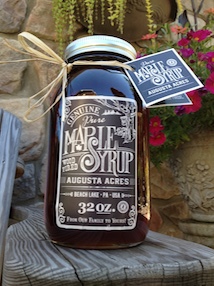
Susan and Todd Klikus of Augusta Acres Farm will be at Anchor Run Farm on Monday, September 18th from 1:00 - 6:30 pm to share their pure maple syrup and pure, raw honey with our CSA! This is a wonderful opportunity to stock your cupboards with local sweets for the winter and/or get an early start on holiday gifts for loved ones who appreciate meaningful and useable treats.
Augusta Acres is located in Beach Lake, PA and is a family-run operation. They farm using only organic methods and are members of Pennsylvania Association for Sustainable Agriculture and the Pennsylvania Maple Producers Association. Sap from trees located strictly on the farm is boiled down in small batches on their wood fired arch to produce a maple syrup that is dark and robust. Their honey is extracted from on-farm apiaries and is an "all season", raw honey which is dark and very sweet. Both sweets will be available for CSA members to purchase at pint and quart sizes for $15 and $24, respectively.
Don't fret if you are unable to make it to the farm on Monday, September 18th between 1:00 and 6:30 pm! If you would still like to participate in this opportunity contact Susan Klikus directly at susanklikus@gmail.com and she will set aside your order to pick up on your regularly scheduled pick up day. Payment is due when you pick up your order at the farm.

September 10, 2017
Greens on the Rise
By Derek McGeehan
Greens on the Rise
By Derek McGeehan
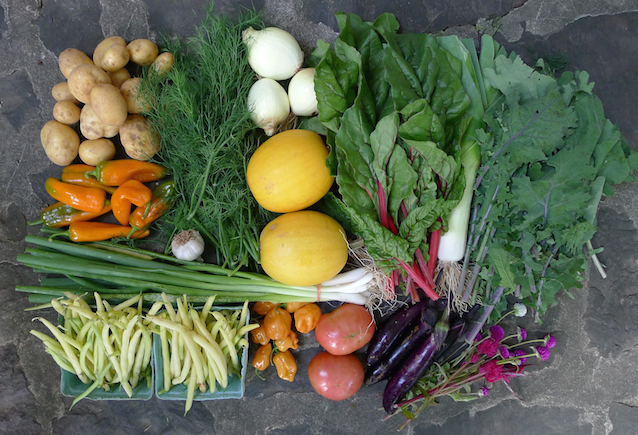
Harvest #18 (Week B) should include winter squash (spaghetti, acorn, sweet dumpling), leeks, onions, sweet peppers, potatoes, kale, Swiss chard, Italian dandelion, parsley, scallions, cilantro, dill, hot peppers, shishito peppers, eggplant, okra, tomatoes, lettuce, garlic, and green tomatoes. Some items will be a choice and may not be available during all pick up times. We may take a break from lettuce to let it size up a bit more before we harvest it next. U-pick should include yellow wax beans and flowers.

September 10, 2017
Announcing: Late Fall CSA and Winter CSA Membership Now Available
By Derek McGeehan
Announcing: Late Fall CSA and Winter CSA Membership Now Available
By Derek McGeehan
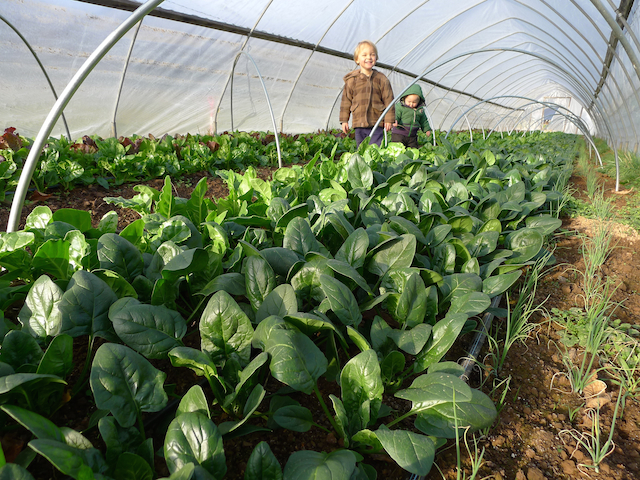
This photo was taken inside the hoop house on December 4th, 2016. Cold hardy spinach, chard, lettuce mix, Gabriel, and Abigail!
2017 Late Fall CSA
- Full, Medium, and Half Shares are available for the 6th annual 6-week season.
- Prices remain the same as last season: $180 for Full; $130 for Medium; $100 for Half.
- A deposit of $50 or full payment secures your share; full payment is due by November 1st; if you join after November 1st full payment is due to finalize registration.
- Pick up days are: Wednesday 1-8pm or Saturday 11am-12noon (you choose a day but you can switch temporarily by notifying us in advance).
- Begins immediately following conclusion of Main Season CSA Harvest Week #26 (Week B, week of November 5th).
- Late Fall Harvest #1 (Week A) is scheduled for week of November 12th.
- Concludes week of December 17th.
- No workshift discount/commitment.
- A cold hardy fall themed continuation of the Main Season share with tasty staples like chard, spinach, lettuce, radicchio, arugula, mizuna, tatsoi, bok choy, kale, collards, cabbage, Napa cabbage, cilantro, dill, parsley, leeks, garlic, scallions, onions, beets, radishes, turnips, carrots, celeriac, kohlrabi, potatoes, and sweet potatoes.
- Each cold season we make improvements to ensure a steady supply of fresh crops, not just storage ones. We now use 4 growing structures to extend the growing season; during our first Late Fall CSA back in 2012 we only had the high tunnel. So, our footprint has effectively tripled (each structure differs somewhat in size) and we now also add heat to the greenhouse for insurance/assurance.
- A Full Share receives approximately 8-12 pounds of produce weekly, a Half Share every other week, and a Medium Share receives 2/3 of a Full Share weekly.
- **During the week of Thanksgiving, Late Fall Harvest Week #2, Wednesday's pick up is on Tuesday, November 21st to accommodate travelers and holiday schedules (we'll accommodate your schedule, too)**. This is the only pick up anomaly.
- To join, log in to the website here; the 'join' button will be on the left hand side of your members page.
- Membership is limited and is at capacity at around 50% of the Main Season number so don't delay!
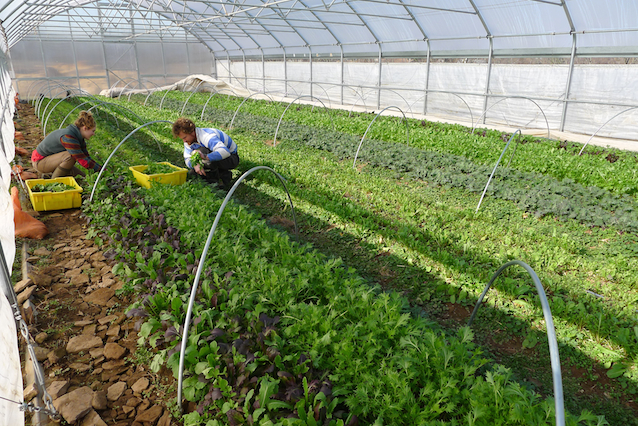
This photo was taken inside the high tunnel on February 18th, 2017. Look at those cold hardy tasty greens of mustard, mizuna, arugula, and kale (plus Hannah and Derek)!
2017-2018 Winter CSA
- Full, Medium, and Half Shares are available for the 2nd annual 10-week season (2 more weeks than last year).
- Prices remain the same as last season: $300 for Full; $220 for Medium; $165 for Half.
- A deposit of $75 or full payment secures your share; full payment is due by December 15th.
- Pick up days are: Wednesday 1-8pm or Saturday 11am-12noon (you choose a day but you can switch temporarily by notifying us in advance).
- Begins immediately following conclusion of Late Fall CSA Harvest Week #6 (Week B, week of December 17th).
- Winter Harvest #1 (Week A) is scheduled for week of December 24th - **This week only, Wednesday's pick up is moved to Thursday, December 28th, to accommodate travelers and holiday schedules (we'll accommodate your schedule, too)**. This is the only pick up anomaly.
- Concludes week of February 25th.
- No workshift discount/commitment.
- A cold hardy winter themed continuation of the Late Fall share with tasty staples like chard, spinach, lettuce, arugula, mizuna, tatsoi, bok choy, kale, collards, cabbage, Napa cabbage, herbs, leeks, garlic, scallions, onions, beets, radishes, turnips, carrots, celeriac, kohlrabi, and potatoes.
- Each cold season we make improvements to ensure a steady supply of fresh crops, not just storage ones. We now use 4 growing structures to extend the growing season; during our first Late Fall CSA back in 2012 we only had the high tunnel. So, our footprint has effectively tripled (each structure differs somewhat in size) and we now also add heat to the greenhouse for insurance/assurance.
- A Full Share receives approximately 8-12 pounds of produce weekly, a Half Share every other week, and a Medium Share receives 2/3 of a Full Share weekly.
- To join, log in to the website here; the 'join' button will be on the left hand side of your members page.
- Membership is limited and is at capacity at around 30% of the Main Season number so don't delay!

September 10, 2017
Essential Oils Class Saturday September 16th 10-11am
By KaLee Lee
Essential Oils Class Saturday September 16th 10-11am
By KaLee Lee
Have you been wondering what all the buzz is about with essential oils? Or, what they could do for you? You are invited to an exciting class on Saturday, September 16th, 10-11am to answer these questions and many more! This class will be full of great lessons learned from hilarious personal experiences, you do not have to learn all of these lessons the hard way. There will be raffles as well as yummy treats and tons of great information. We will be learning about the basics of essential oils, how you can support the wellness of you and your family, and how to eliminate chemicals from your home. Cannot wait to see you there!

September 10, 2017
Workshifts Scheduled for Week of 9/10/17
By Derek McGeehan
Workshifts Scheduled for Week of 9/10/17
By Derek McGeehan
If you still need to work your pledged hours please consider signing up for a workshift soon! In other words, when you joined the CSA you purchased a share "with work discount" instead of a share "without working". If you'd rather contribute financially to cover the work hour cost of your share please do so soon so that we can plan accordingly. And please don't feel guilty about it! The buyout option makes it fair for all members.
$60 covers the 4 hours for a Half Share; $90 covers the 6 hours for a Medium Share; and $120 covers the 8 hours for a Full Share. E-mail us at anchorruncsa@gmail.com if you have any questions.
Workshifts this week:
- Tuesday 9/12 10am-12noon
- Wednesday 9/13 10am-12noon
- Friday 9/15 10am-12noon
- Sunday 9/17 8-10am
- Wednesday 9/13 10am-12noon
- Friday 9/15 10am-12noon
- Sunday 9/17 8-10am
Workshift sign-up instructions may be found here.
Thank you!

September 10, 2017
Book Drive
By Shyla Janannatha
Book Drive
By Shyla Janannatha
Shyla Jagannatha, a member of our CSA, is conducting a book drive through the American Association of University Women - Makefield Area Branch (a 501(c)(3) organization), where she is a board member. The book drive is for the Cops 'n' Kids initiative through the branch. Cops 'n' Kids is a community literacy project to collect and donate books to children who need them and in the process help each child feel connected to their own community. To learn more about the initiative or to get involved, please visit the website. They are looking for new and very gently used books for children of all ages, but are especially in need of books for ages less than 8. If you have books to share, please bring the books in and drop them off in the collection bin marked "Cops 'n' Kids - Donate Here". Together with the AAUW-Makefield Area Branch, let's make a difference in the lives of children in our community!

September 3, 2017
Next Potluck Saturday 9/9/17
By Derek McGeehan
Next Potluck Saturday 9/9/17
By Derek McGeehan

Thank you swallowtail butterfly!
Our next farm potluck meal is Saturday September 9th. We'll probably start this one at 5pm since it will be getting dark earlier. We may have a small fire if the weather allows. Join us under the pavilion for a nice meal shared with your community. Bring a dish to share that is large enough to feed 4-6 adults, your own place settings, and any beverage of your choosing. A brief note/label next to your dish will be helpful to folks with dietary restrictions.

September 3, 2017
Fall Crops Begin - Leeks and Winter Squash
By Linda Dansbury
Fall Crops Begin - Leeks and Winter Squash
By Linda Dansbury
Well, it definitely feels like fall as I write this, but it is supposed to warm up significantly in a couple of days. September is what I think of as the crossover season. We still enjoy our favorite summer crops of tomatoes, eggplant and peppers, and we begin to see fall crops like more greens, leeks and winter squash.
I think most people are familiar with leeks - delicious in soups and stews! If you purchase leeks in the store, you probably dread cleaning them because the sandy soil they are grown in is difficult to remove. Anchor Run leeks are so much easier - they just need a simple rinse - nothing in between all the layers! Leeks store really well in the refrigerator so if you are like me and still have onions left, use them up before using your leeks.
Winter Squash - the farmers grow many different kinds of squash - the first ones we will see are spaghetti, dumpling and acorn. All winter squash store well in cool, dry conditions. A basement is ideal. Right now the garage would be good, but with the warm up coming this week, it will not be the best location. Acorn will store the longest of the three, but they will all be good for at least 3 months - they won't last that long in my home! Farmer Derek note: We recommend eating these three winter squash varieties sooner rather than later due to field conditions they grew in and elements that they were exposed to: humidity, bugs, disease pressures, etc. A slight, even unnoticed blemish, will quickly deteriorate the squash in storage. At the farm we're still fine-tuning winter squash growing, harvesting, and storing; this season we're storing them at 50 degrees which should preserve them longer. For us, butternuts seem to keep longest.
Spaghetti Squash when cooked is what it sounds like - it comes out of the shell in strings, or spaghetti. There are many ways to cook it - steam, microwave or bake. They can be cooked whole or cut in half and cooked. I have had the most reliable success of cooking to the right texture by cutting them in half and baking with the cut side down until a fork goes through fairly easily. Time has to be watched because these squash come in so many sizes - start checking at about 30 min for a small one baked at 375. Check out this site for many spaghetti squash recipes including Italian Spaghetti Squash which I really like for now because it incorporates pepper and tomatoes. Replace the basil with parsley. Also try the Spaghetti Squash and Pork Stir Fry - Yum! Or, cook the squash and top with your favorite sauce.
Dumpling and Acorn Squash are a couple of my favorites. The flavor of them is so sweet. They are also small so a half makes a perfect sized side dish. Just cut in half, remove seeds, place a bit of butter on the cut part, sprinkle with salt and pepper and bake till tender. Or, add honey or maple syrup and a bit of cinnamon for a real taste of fall. One of the dishes I like for this time of year is the Southwestern Stuffed Acorn Squash. It again incorporates summer veggies and tastes more like summer - perfect for this "crossover" season.

September 3, 2017
Summer and fall meals
By Linda Dansbury
Summer and fall meals
By Linda Dansbury
This past week's weather had us all scratching our heads about what we wanted to eat - warm and humid, to sunny and cool to downright damp and chilly!
I have found the best way for me to keep my thoughts organized is to make lists. Each week when I get home with my harvest I arrange and rearrange the veggies I have, putting the older and more perishable ones in the front of the fridge and make a list of what I have. Then, as I think of things I want to make or have for dinner, I write that list. This simple method helps me remember what is in the fridge and also aids in deciding what to have for dinner. Below are some of the thing I did this past week.
Tomato, onion, parsley - made tomato sauce. My method is pretty simple: Saute onions in olive oil under low heat until soft and translucent. Add tomatoes that have been roughly chopped and start to cook them down. Add a can of tomato paste, salt and pepper and any herbs you desire. When thickened, run it through a food mill and use or freeze.
Peppers, onions, garlic, herbs - we have received a lot of fresh onions and peppers recently and I was trying to figure out what to do with all of them. I made a big batch of sauteed peppers and onions. Just cut them all up and cooked on top of the stove until browned and tender. I then had them to use for a variety of dishes: I made a frittata for dinner one night using the peppers and onions as part of the add-ins. We will be having sausage sandwiches with them. I also did a side dish in which I cooked up the greens, mixed in some peppers and onions, and grated parmasan cheese over the top of it.
Eggplant, peppers, tomatoes, onions, garlic - finally made Caponata - so glad I got to it before my eggplants went south! I froze it in small containers to be eaten through the winter. It can be used as bruschetta, or it can be a side dish for meats. I often eat it with a nice sausage over pasta.

September 3, 2017
Slow Transition to Veggies of Autumn
By Derek McGeehan
Slow Transition to Veggies of Autumn
By Derek McGeehan
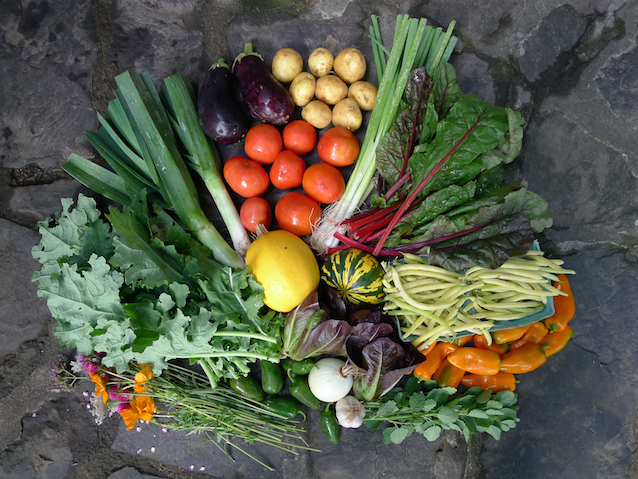
Harvest #17 (Week A) should include scallions, onions, leeks, kale, sweet peppers, winter squash (spaghetti, sweet dumpling, or acorn), hot peppers, shishito peppers, Swiss chard, Italian dandelion, lettuce, tomatoes, eggplant, potatoes, garlic, okra, carrots, and herbs. Some items will be a choice and may not be available during all pick up times. U-pick should include yellow wax beans, flowers, and herbs.

September 3, 2017
Now What!? Workshop Fall Edition
by Gia Yaccarino
Now What!? Workshop Fall Edition
by Gia Yaccarino
Greetings fellow farm members! I am trying to get a feel for whether or not there is interest in a Fall Edition of the Now What!? Workshop. The workshop would probably be scheduled for a weekend (Saturday or Sunday) in late September or Early October. If you are interested, please contact me via email at thatgiagirl@comcast.net and please include ARF in the subject line. Let me know what you are interested in discussing and learning more about!
New members, longtime members, members who attended a previous Now What!? workshop, members who did not attend a previous Now What!? workshop (in other words - all members!) are welcome to attend!

September 3, 2017
Workshifts Scheduled for Week of 9/3/17
By Derek McGeehan
Workshifts Scheduled for Week of 9/3/17
By Derek McGeehan

Casting for the magical and illusive Anchor Run Farm fish.
We're past the halfway point of the season for work hour opportunities. Workshifts will be scheduled through October but frequency will diminish in September. If you still need to work your pledged hours please consider signing up for a workshift soon. If you'd rather contribute financially to cover the work hour cost of your share please do so soon so that we can plan accordingly. E-mail us at anchorruncsa@gmail.com if you have any questions.
Workshifts this week:
- Tuesday 9/5 10am-12noon
- Wednesday 9/6 6-8pm (garlic processing in barn; rain or shine)
- Friday 9/8 10am-12noon
- Sunday 9/10 7-9am
- Wednesday 9/6 6-8pm (garlic processing in barn; rain or shine)
- Friday 9/8 10am-12noon
- Sunday 9/10 7-9am
Workshift sign-up instructions may be found here.
Thank you!

September 3, 2017
Out of Summer, Into September
By Derek McGeehan
Out of Summer, Into September
By Derek McGeehan
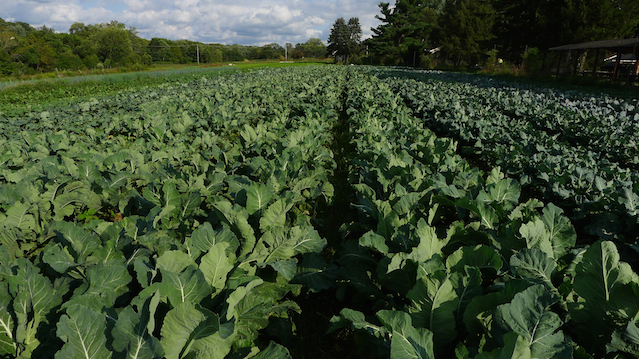
Fall crops doing well: cauliflower, broccoli, cabbage, kale, beets, leeks, chard, and celeriac.
Astronomically it remains summer, meteorologically we've moved to fall, and with a low of 44 degrees at the bottom of our field on Friday morning, one would assume that we're deep in October. Highs in the 60s for a few days, followed by forecast highs in the mid-80s to start this week, then a roller coaster plunge later in the week and the weather ride continues. Agronomically the summer crops are waning, the fall ones are thriving, and everything is growing a bit slower with the lower temperatures and reduced daylength. Internally, our thoughts drift more towards preparing for fall and winter harvests, knowing that our time to plant is coming to a close for another season. We're beginning to prepare the hoop house, greenhouse, and high tunnel areas for Late Fall and Winter CSA crops, even contemplating adding another tunnel to the farm. A cover crop mixture of oats, buckwheat, daikon radish, and crimson clover was sown over a significant portion of the farm last week, prior to the midweek rain event. That event plus yesterday's were the ideal way for rain to fall, slow and steady. Both deposited about a half-inch, a perfect amount for the farm and to get those cover crops up and growing. This season we've benefitted from practically an ideal amount of moisture without heat, approximately 4.5-6.5 inches per month from May through August. There was only one week in there that we had to wait until Friday to actively work with the soil. Thank you mother nature weather woman!

September 3, 2017
Late Fall and Winter CSA Seasons to be Announced Soon
By Derek McGeehan
Late Fall and Winter CSA Seasons to be Announced Soon
By Derek McGeehan
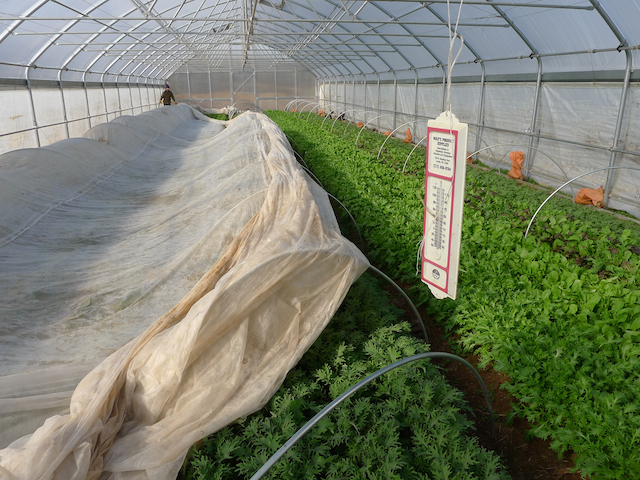
Mid-January in the high tunnel. Under a few layers of protection it's more like November. Winter hardy greens such as kale, arugula, mizuna, spinach, and chard thrive indoors in the winter.
Membership will soon be available for our 6-week Late Fall CSA and 10-week Winter CSA. We'll e-mail current Main Season members with details and sign up information this week (probably).

POSTS BY TYPE
POSTS BY MONTH

